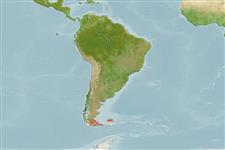Polyplacophora |
Chitonida |
Chitonidae
Environment: milieu / climate zone / depth range / distribution range
Ecology
Benthic; depth range 0 - 36 m (Ref. 87801). Temperate; 52°S - 55°S, 70°E - 61°E (Ref. 83435)
Southeast Pacific, Southwest Atlantic and Antarctic Atlantic.
Length at first maturity / Size / Weight / Age
Maturity: Lm ? range ? - ? cm Max length : 7.0 cm DL male/unsexed; (Ref. 83435)
Found on rocks and undersides of stones and boulders on sandy bottoms, often between Macrocystis, Bryozoa, polychaete-tubes, crustallinous red algae and bivalves; also near bacteria mats that are associated with volcanic springs (Ref. 87801).
Life cycle and mating behavior
Maturity | Reproduction | Spawning | Eggs | Fecundity | Larvae
Members of the class Polyplacophora are mostly gonochoric. Life cycle: Eggs hatch into lecitotrophic planktonic trocophore larvae (no veliger stage) which later metamorphose and settle on the bottom as young adults.
Rosenberg, G. 2009 Malacolog 4.1.1: A Database of Western Atlantic Marine Mollusca. [WWW database (version 4.1.1)] URL http://www.malacolog.org/. (Ref. 83435)
IUCN Red List Status
(Ref. 130435: Version 2025-1)
CITES status (Ref. 108899)
Not Evaluated
Not Evaluated
Threat to humans
Human uses
| FishSource |
Tools
More information
Trophic EcologyFood items (preys)Diet compositionFood consumptionPredators Population dynamicsGrowth
Max. ages / sizes
Length-weight rel.
Length-length rel.
Length-frequencies
Mass conversion
Abundance
Life cycleReproductionMaturityFecunditySpawningEggsEgg developmentLarvae PhysiologyOxygen consumption
Human RelatedStamps, coins, misc.
Internet sources
Estimates based on models
Preferred temperature
(Ref.
115969): 2.2 - 8.3, mean 7.3 (based on 100 cells).
Fishing Vulnerability
Low vulnerability (10 of 100).
Price category
Unknown.
